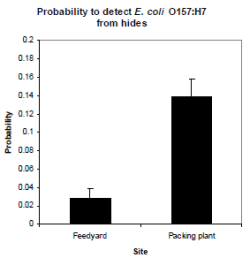Project Summary
Effect of Vaccinating Against Type III Secreted Proteins of Escherichia coli O157:H7 on the Occurrence of E. coli O157:H7 on Hides Pre- and Post-Harvest
- Principle Investigator(s):
- Terry Klopfenstein
- Institution(s):
- University of Nebraska
- Completion Date:
- November 2005
Background
From 1993 to 2002, it is estimated that E. coli O157:H7 cost the beef industry an estimated $2.7 billion. Historically, the interventions to reduce E. coli O157:H7 contamination of beef products have targeted the processing segments of the beef industry. Decreasing the incidence of E. coli O157:H7 involves multiple interventions across all segments of the beef production chain. This study focuses on identifying critical control points for pathogen reduction in the production segment of the beef industry.
Previous research indicates that vaccination can reduce the proportion of feedlot cattle shedding E. coli O157:H7 in the feces. However, the effect of that vaccine on subsequent hide contamination at harvest has yet to be evaluated. Additionally, it can be argued that pre-harvest interventions aimed at reducing the carriage and shedding of E. coli O157:H7 in feedlot cattle will reduce hide contamination at the feedlot, but not at the packing facility. Transport and lairage may have a considerable impact on cross contamination of hides.
The objectives of this study were as follows:
- Evaluate the effects of vaccinating cattle against type III secreted proteins of E. coli on the occurrence of E. coli O157:H7 on hides pre- and post-harvest; and
- Evaluate the effects of transport and lairage on hide contamination.
Methodology
An initial feedlot finishing study was conducted with winter-fed cattle harvested in the spring of 2005. Due to the small number of E. coli O157:H7 positive hide samples (16 of 737 hide cultures) a second study was conducted with summer-fed cattle harvested in September 2005.
For the second study, 336 steers were grown in a winter grazing system until they were placed on trial in the spring of 2005. Steers were sorted by weight and placed into 3 treatment groups (each treatment group containing 112 head). Within each group, steers within pens were assigned randomly to one of two vaccination treatments (i.e., vaccinated or non-vaccinated). Two doses of vaccine (2 ml dose SQ in the neck) were given to vaccinated steers and 2 doses of placebo were given to non-vaccinated steers on the same day. A second dose of vaccine was administered at re-implant, approximately one month after the first vaccination.
All steers were harvested after 117 days on feed (85 days post treatment). A hide sample (pre-harvest) was collected from each of the steers at the feedlot the day they were sent to harvest. Steers within the same treatment group were loaded onto clean trucks at the feedlot, held in lairage at the plant within the same treatment group, and harvested within the same treatment group. Hide samples were collected at the packing plant (post-harvest) from all steers sent to harvest.
Findings
Nine percent (56 of 621) of the hide-cultures tested positive for E. coli O157:H7. Overall, vaccination reduced the probability of hide-contamination 44%. Accounting for pre- and post-harvest measures, the probability for hides of vaccinated cattle to test positive for E. coli O157:H7 was 0.048, whereas the probability for non-vaccinated cattle to test positive for E. coli O157:H7 was 0.086 (See Figure 1). Vaccination was equally protective at the feedlot and at the processing facility.
The probability of detecting E. coli O157:H7 on hides post-harvest was nearly five times greater than that of detecting E. coli O157:H7 on hides pre-harvest at the feedlot. This is not surprising since previous research suggests transport and lairage can facilitate extensive spread of pathogenic bacteria. Accounting for vaccination, the probability to detect E. coli O157:H7 on hides at the feedlot was 0.028; whereas, the probability to detect E. coli O157:H7 on hides post-harvest at the packing plant was 0.138 (See Figure 2). The increased probability for hide-contamination post-harvest was observed in all three treatment groups.
Implications
The results of this study suggest that a considerable amount of cross contamination can occur from pre-harvest to post-harvest (during transport and lairage). In this study vaccination reduced the probability of recovering E. coli O157:H7 from cattle hides. Vaccination or other pre-harvest intervention strategies aimed at reducing the carriage and shedding of E. coli O157:H7 may prove beneficial for reducing the magnitude of the cross contamination occurring during transport from the feedlot.

Figure 1. The probability for vaccinated and non-vaccinated cattle to have E. coli O157:H7 hide contamination, adjusted for pre- and post-harvest measures.

Figure 2. The probability for cattle to have E. coli O157:H7 hide contamination pre- and post-harvest, adjusted for vaccination treatment.